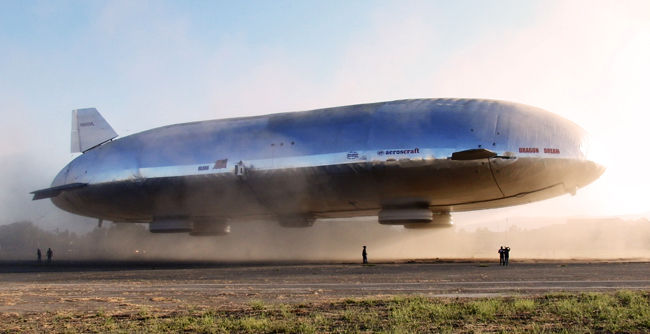
Two days after receiving experimental airworthiness certification from the Federal Aviation Administration Aeros Corp. began flight-testing the Aeroscraft airship. For safety, the current flights are tethered, and, according to John Kiehle, communications director at Aeros, untethered flights are expected to follow within few weeks. Francis Govers of Gizmag reports.
The Aeroscraft half scale prototype is 266 ft (79 m) long and 97 ft (29.5m) wide. The final design is expected to be more than 400 feet (121m) long and be able to lift a cargo weight of 66 tons. The prototype is powered by three swiveling engines – two on the sides and one in the back – that provide both lift and thrust to lift the airship into the air and propel it forward. The rear engine gives control at low airspeeds by pushing the tail around, side to side or up and down. Two sets of wing-like control surfaces are mounted fore and aft, and two large rudders push up vertically from the tail end. These aerodynamic surfaces will be used at higher speeds (above 20 mph / 30 kph).
The Aeroscraft is a fully rigid airship, of the type that has not been seen in the air since 1940. A rigid airship has a stiff outer frame that maintains its aerodynamic shape regardless of the amount of helium inside the ship. The Aeroscraft maintains a given capacity of helium in pressurized containers. When loaded with cargo, helium will be expanded into buoyancy containers, like air is used to float submarines. The company calls this system COSH, an acronym for “Control of Static Heaviness.”
The rationale for bringing back this type of airship relates to its ability to deliver heavy, outsized cargo to remote locations without needing an airport to land at. Communities in locations like Alaska, the north of Canada, Africa, and the Australian outback are rich in minerals but lacking in infrastructure. It is the vision of Pasternak and his crew that the Aeroscraft will transform the delivery of cargo to mines, wind farms and oil fields in remote areas like these.
The Aeroscraft has been under development since 2006, and the US Government has contributed some $35M for research, along with expertise in aerodynamics and control systems from NASA.


















